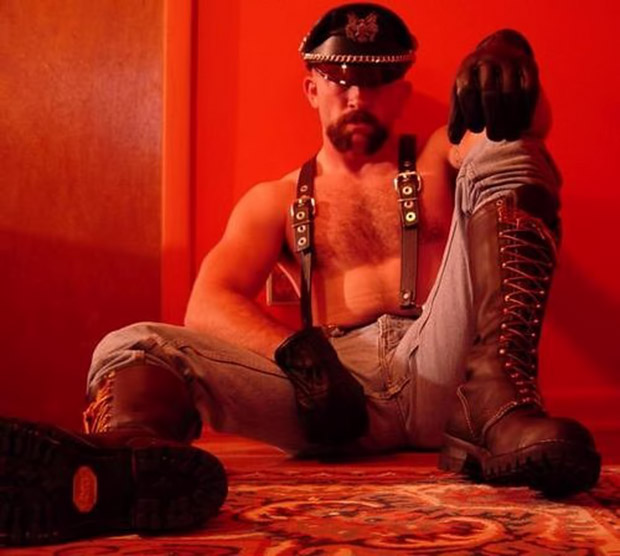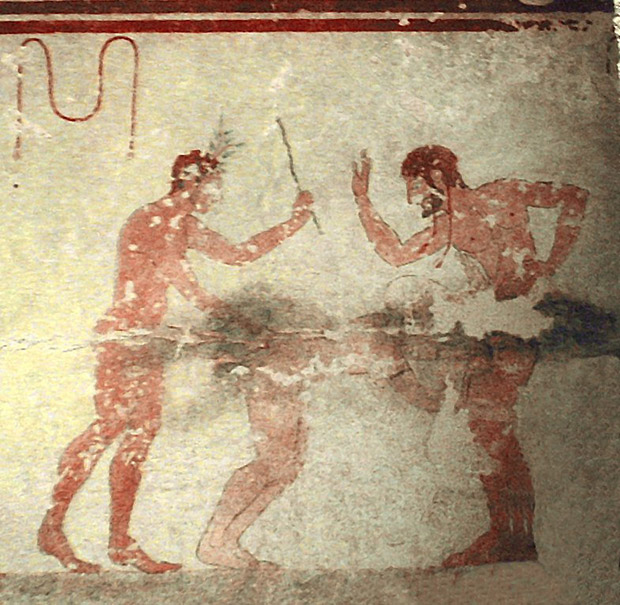Porn is rich in history and all kinds of things for discussion, but today I just wanted to do a quick rollercoaster-ride through BDSM in America, where it’s come from and why it looks the way it does.
BDSM images date back much further than modern history, in fact it can be traced back for centuries. Here’s a fresco from Tomba della Fustigazione (the Tomb of the Whipping), an Etruscan tomb in Italy, that dates back to 490BC:
In an era before information moved faster than the speed of light, social expressions of BDSM in terms of imagery developed with their own cultural nuance in the USA, with a different tone and feel to Asia or Europe.
There’s a lot of myth surrounding BDSM history, but most historians agree that the modern image of BDSM in the US had its seeds in gay leather biker culture that arose post WWII.

The 1950s were a tough time to be transgressive, and the mood of the era was distinctly “nuclear family values”. It was not an era where Americans felt free to openly express their sexuality, and so pornography came largely from “camera clubs” created within underground counter-cultures.
The biker culture quickly influenced mainstream trends and fashion, leading to the “greasers”, who flirted with transgression in the idea of the outlaw or rebel.
Pin-up model Bettie Page began working with Irving Klaw in 1952, posing for mail-order photographs with BDSM themes and acting (sometimes as Dominatrix, sometimes as submissive) in short black and white “BDSM specialty films” showing fetish scenarios such as abduction, slave training, bondage and spanking. She, and the other models in the film, were clad in lingerie and high heels, and sometimes leather costumes, and the fashion of these films would still look contemporary at a play party today.
The films of Irving Klaw didn’t feature nudity or explicit sex, but they were the forerunner for the 1960’s pornographic videos which went further into the rope ties and fetish wear themes. A key component of these films however was that they were all filled with smiling, playfully flirtatious women. Images were kinky, but they weren’t getting dark.
In 1972, Gerard Damiano’s extremely successful film Deep Throat, starring Linda Lovelace, changed all that and really shifted way female sexuality was portrayed, with its story of a woman being and enjoying being extremely sexual.
If you’re not familiar with the plot of Deep Throat, a doctor discovers that the reason Linda is not achieving sexual satisfaction is that her clitoris is actually in her throat. She then uses her newfound skills as a therapist to help frustrated men.
The same year, Behind the Green Door was the first feature-length hardcore film to feature inter-racial sex, and included a multi-partner scene performed on a trapeze-like contraption suspended from the ceiling. The German-Franco film Story of O, released in 1975, also found a wide mixed-gender audience and centered around a young woman trained in submission via sexual sadomasochism.
This led to much darker and more aggressive BDSM imagery, and the 1980s was full of images of darker, femme fatal nearly dominatrix-esque women, which continued into the age of the internet.
In 1996, Peter Acworth, a bondage fan, created hogtied.com (now known as kink.com) and soon began shooting his own videos. Highly niche at the time, it was very successful and this success filtered out to the pornography industry in general, with others trying to cash in on the audience. It could still be brutal, but kink.com showed a more approachable side of kink, with performer interviews and behind-the-scenes sequences.
It’s really at this point that we see what some people refer to as the “mainstreaming of kink”. As BDSM became more mainstream within pornography it began to appear in more people’s viewing feeds, by accident or deliberately, and entered the conversation for more people. Some realized it was something they were interested in, and more and more places for people to find like-minded groups flourished, online and offline. 2008 saw the launch of the FetLife juggernaut, and now (thanks to 50 Shades of Grey) it is not a particularly shocking or even surprising feature in pop-culture.



